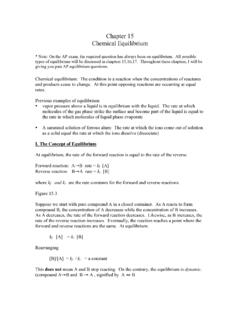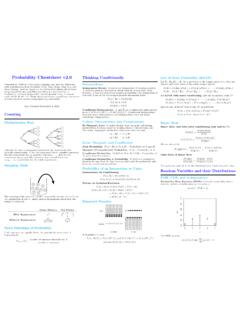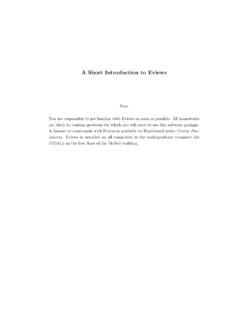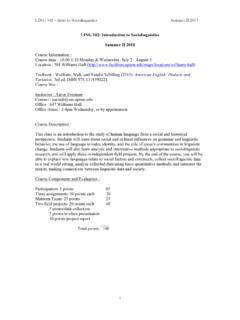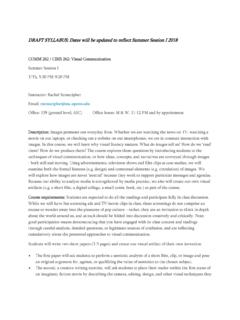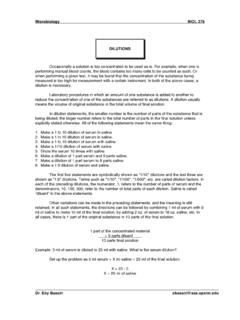Transcription of NMRChemicalShiftsofCommon …
1 7512 J. Org. Chem. 1997, 62, 7512-7515. NMR Chemical Shifts of Common Laboratory Solvents as Trace Impurities Hugo E. Gottlieb,* Vadim Kotlyar, and Abraham Nudelman*. Department of Chemistry, Bar-Ilan University, Ramat-Gan 52900, Israel Received June 27, 1997. In the course of the routine use of NMR as an aid for organic chemistry, a day-to-day problem is the identifica- tion of signals deriving from common contaminants (water, solvents, stabilizers, oils) in less-than-analyti- cally-pure samples. This data may be available in the literature, but the time involved in searching for it may be considerable. Another issue is the concentration dependence of chemical shifts (especially 1H); results obtained two or three decades ago usually refer to much Figure 1. Chemical shift of HDO as a function of tempera- more concentrated samples, and run at lower magnetic ture. fields, than today's practice.
2 We therefore decided to collect 1H and 13C chemical dependent (vide infra). Also, any potential hydrogen- Published on October 17, 1997 on | doi: shifts of what are, in our experience, the most popular bond acceptor will tend to shift the water signal down- extra peaks in a variety of commonly used NMR field; this is particularly true for nonpolar solvents. In solvents, in the hope that this will be of assistance to contrast, in DMSO the water is already strongly the practicing chemist. hydrogen-bonded to the solvent, and solutes have only a Downloaded by UNIV OF PENN on August 4, 2009. negligible effect on its chemical shift. This is also true Experimental Section for D2O; the chemical shift of the residual HDO is very NMR spectra were taken in a Bruker DPX-300 instrument temperature-dependent (vide infra) but, maybe counter- ( and MHz for 1H and 13C, respectively). Unless intuitively, remarkably solute (and pH) independent.
3 Otherwise indicated, all were run at room temperature (24 ( 1 We then added 3 L of one of our stock solutions to C). For the experiments in the last section of this paper, probe the NMR tube. The chemical shifts were read and are temperatures were measured with a calibrated Eurotherm 840/T presented in Table 1. Except where indicated, the digital thermometer, connected to a thermocouple which was introduced into an NMR tube filled with mineral oil to ap- coupling constants, and therefore the peak shapes, are proximately the same level as a typical sample. At each essentially solvent-independent and are presented only temperature, the D2O samples were left to equilibrate for at least once. 10 min before the data were collected. For D2O as a solvent, the accepted reference peak ( . In order to avoid having to obtain hundreds of spectra, we ) 0) is the methyl signal of the sodium salt of 3-(trimeth- prepared seven stock solutions containing approximately equal ylsilyl)propanesulfonic acid; one crystal of this was added amounts of several of our entries, chosen in such a way as to prevent intermolecular interactions and possible ambiguities in to each NMR tube.
4 This material has several disadvan- assignment. Solution 1: acetone, tert-butyl methyl ether, di- tages, however: it is not volatile, so it cannot be readily methylformamide, ethanol, toluene. Solution 2: benzene, di- eliminated if the sample has to be recovered. In addition, methyl sulfoxide, ethyl acetate, methanol. Solution 3: acetic unless one purchases it in the relatively expensive acid, chloroform, diethyl ether, 2-propanol, tetrahydrofuran. deuterated form, it adds three more signals to the Solution 4: acetonitrile, dichloromethane, dioxane, n-hexane, spectrum (methylenes 1, 2, and 3 appear at , , HMPA. Solution 5: 1,2-dichloroethane, ethyl methyl ketone, n-pentane, pyridine. Solution 6: tert-butyl alcohol, BHT, cyclo- and ppm, respectively). We suggest that the re- hexane, 1,2-dimethoxyethane, nitromethane, silicone grease, sidual HDO peak be used as a secondary reference; we triethylamine.
5 Solution 7: diglyme, dimethylacetamide, ethyl- find that if the effects of temperature are taken into ene glycol, grease (engine oil). For D2O. Solution 1: acetone, account (vide infra), this is very reproducible. For D2O, tert-butyl methyl ether, dimethylformamide, ethanol, 2-propanol. we used a different set of stock solutions, since many of Solution 2: dimethyl sulfoxide, ethyl acetate, ethylene glycol, the less polar substrates are not significantly water- methanol. Solution 3: acetonitrile, diglyme, dioxane, HMPA, pyridine. Solution 4: 1,2-dimethoxyethane, dimethylacetamide, soluble (see Table 1). We also ran sodium acetate and ethyl methyl ketone, triethylamine. Solution 5: acetic acid, tert- sodium formate (chemical shifts: and ppm, butyl alcohol, diethyl ether, tetrahydrofuran. In D2O and respectively). CD3OD nitromethane was run separately, as the protons Carbon Spectra (Table 2).
6 To each tube, 50 L of exchanged with deuterium in presence of triethylamine. the stock solution and 3 L of TMS1 were added. The solvent chemical shifts3 were obtained from the spectra Results containing the solutes, and the ranges of chemical shifts Proton Spectra (Table 1). A sample of mL of the solvent, containing 1 L of TMS,1 was first run on its (2) , the signal of the proton for the isotopomer with one less deuterium than the perdeuterated material, , CHCl3 in CDCl3 or own. From this spectrum we determined the chemical C6D5H in C6D6. Except for CHCl3, the splitting due to JHD is typically shifts of the solvent residual peak2 and the water peak. observed (to a good approximation, it is 1 of the value of the It should be noted that the latter is quite temperature- corresponding JHH). For CHD2 groups (deuterated acetone, DMSO, acetonitrile), this signal is a 1:2:3:2:1 quintet with a splitting of ca.
7 2. Hz. (1) For recommendations on the publication of NMR data, see: (3) In contrast to what was said in note 2, in the 13C spectra the IUPAC Commission on Molecular Structure and Spectroscopy. Pure solvent signal is due to the perdeuterated isotopomer, and the one- Appl. Chem. 1972, 29, 627; 1976, 45, 217. bond couplings to deuterium are always observable (ca. 20-30 Hz). S0022-3263(97)01176-6 CCC: $ 1997 American Chemical Society Notes J. Org. Chem., Vol. 62, No. 21, 1997 7513. Table 1. 1H NMR Data proton mult CDCl3 (CD3)2CO (CD3)2SO C6D6 CD3CN CD3OD D2O. solvent residual peak H2O s acetic acid CH3 s acetone CH3 s acetonitrile CH3 s benzene CH s tert-butyl alcohol CH3 s OHc s tert-butyl methyl ether CCH3 s OCH3 s BHTb ArH s OHc s ArCH3 s ArC(CH3)3 s chloroform CH s cyclohexane CH2 s 1,2-dichloroethane CH2 s dichloromethane CH2 s diethyl ether CH3 t, 7 CH2 q, 7 diglyme CH2 m CH2 m OCH3 s Published on October 17, 1997 on | doi: 1,2-dimethoxyethane CH3 s CH2 s dimethylacetamide CH3CO s NCH3 s NCH3 s Downloaded by UNIV OF PENN on August 4, 2009.
8 Dimethylformamide CH s CH3 s CH3 s dimethyl sulfoxide CH3 s dioxane CH2 s ethanol CH3 t, 7 CH2 q, 7d OH sc,d ethyl acetate CH3CO s CH2CH3 q, 7 CH2CH3 t, 7 ethyl methyl ketone CH3CO s CH2CH3 q, 7 CH2CH3 t, 7 ethylene glycol CH se grease f CH3 m CH2 br s n-hexane CH3 t CH2 m HMPAg CH3 d, methanol CH3 sh OH sc,h nitromethane CH3 s n-pentane CH3 t, 7 CH2 m 2-propanol CH3 d, 6 CH sep, 6 pyridine CH(2) m CH(3) m CH(4) m silicone greasei CH3 s tetrahydrofuran CH2 m CH2O m toluene CH3 s CH(o/p) m CH(m) m triethylamine CH3 t,7 CH2 q, 7 a In these solvents the intermolecular rate of exchange is slow enough that a peak due to HDO is usually also observed; it appears at and ppm in acetone and DMSO, respectively. In the former solvent, it is often seen as a 1:1:1 triplet, with 2JH,D ) 1 Hz. b 2,6-Dimethyl-4-tert-butylphenol. c The signals from exchangeable protons were not always identified. d In some cases (see note a), the coupling interaction between the CH2 and the OH protons may be observed (J ) 5 Hz).
9 E In CD3CN, the OH proton was seen as a multiplet at , and extra coupling was also apparent on the methylene peak. f Long-chain, linear aliphatic hydrocarbons. Their solubility in DMSO was too low to give visible peaks. g Hexamethylphosphoramide. h In some cases (see notes a, d), the coupling interaction between the CH3 and the OH protons may be observed (J ) Hz). i Poly(dimethylsiloxane). Its solubility in DMSO was too low to give visible peaks. show their degree of variability. Occasionally, in order ambiguous, a further 1-2 L of a specific substrate were to distinguish between peaks whose assignment was added and the spectra run again. 7514 J. Org. Chem., Vol. 62, No. 21, 1997 Notes Table 2. 13C NMR Dataa CDCl3 (CD3)2CO (CD3)2SO C6D6 CD3CN CD3OD D2O. solvent signals ( ( ( ( ( ( ( ( acetic acid CO CH3 acetone CO CH3 acetonitrile CN CH3 benzene CH tert-butyl alcohol C CH3 tert-butyl methyl ether OCH3 C CCH3 BHT C(1) C(2) CH(3) C(4) CH3Ar CH3C C chloroform CH cyclohexane CH2 Published on October 17, 1997 on | doi: 1,2-dichloroethane CH2 dichloromethane CH2 diethyl ether CH3 CH2 diglyme CH3 Downloaded by UNIV OF PENN on August 4, 2009.)))))))
10 CH2 CH2 1,2-dimethoxyethane CH3 CH2 dimethylacetamide CH3 CO NCH3 NCH3 dimethylformamide CH CH3 CH3 dimethyl sulfoxide CH3 dioxane CH2 ethanol CH3 CH2 ethyl acetate CH3CO CO CH2 CH3 ethyl methyl ketone CH3CO CO CH2CH3 CH2CH3 ethylene glycol CH2 grease CH2 n-hexane CH3 CH2(2) CH2(3) HMPAb CH3 methanol CH3 nitromethane CH3 n-pentane CH3 CH2(2) CH2(3) 2-propanol CH3 CH pyridine CH(2) CH(3) CH(4) silicone grease CH3 tetrahydrofuran CH2 CH2O toluene CH3 C(i) CH(o) CH(m) CH(p) triethylamine CH3 CH2 a See footnotes for Table 1. b 2J ) 3 Hz. c Reference material; see text. PC. Notes J. Org. Chem., Vol. 62, No. 21, 1997 7515. For D2O solutions there is no accepted reference for data are shown in Figure 1. The solid line connecting carbon chemical shifts. We suggest the addition of a drop the experimental points corresponds to the equation of methanol, and the position of its signal to be defined as ppm; on this basis, the entries in Table 2 were ) - + ( 10-5)T2 (1).
